Imagine climbing through wild gorges, rappelling down waterfalls, jumping into crystal-clear pools, and sliding down natural rock chutes – that’s canyoning! This action-packed mix of climbing, swimming, and hiking originated in southern France and Spain and now delivers adrenaline rushes all over Europe.
Whether you’re a beginner or a pro, canyoning takes you to breathtaking places that would otherwise be unreachable. In this article, I’ll explain what canyoning is, share the 8 best spots for canyoning in Europe, and things you need to know before your canyoning adventure!
Before we start, here an overview of the topics for this guide:
- What is Canyoning?
– Canyoning Techniques & Terminology
– Who can do Canyoning?
– Physical Requirements & Group Canyoning Tours
– The best time to do Canyoning
– The right Equipment - The 8 Best Spots in Europe for Canyoning
- FAQ & Tips for Beginners
Get ready for an unforgettable adventure full of thrills, teamwork, and pure nature!
What is Canyoning?
Canyoning is an exhilarating outdoor sport that blends hiking, climbing, abseiling, swimming, and even cliff jumping as you explore breathtaking natural landscapes. Though relatively new to the adventure scene, it has quickly gained popularity as a thrilling way to navigate through river systems and rugged gorges using a variety of techniques.
This sport takes place in dynamic environments, both wet and dry, and allows adventurers to traverse different geological features such as canyons, ravines, gorges, caves, caverns, and even frozen waterfalls. As you descend, you’ll encounter natural rock slides, hidden pools, and steep drops that require rappelling, swimming, or leaping into the unknown.
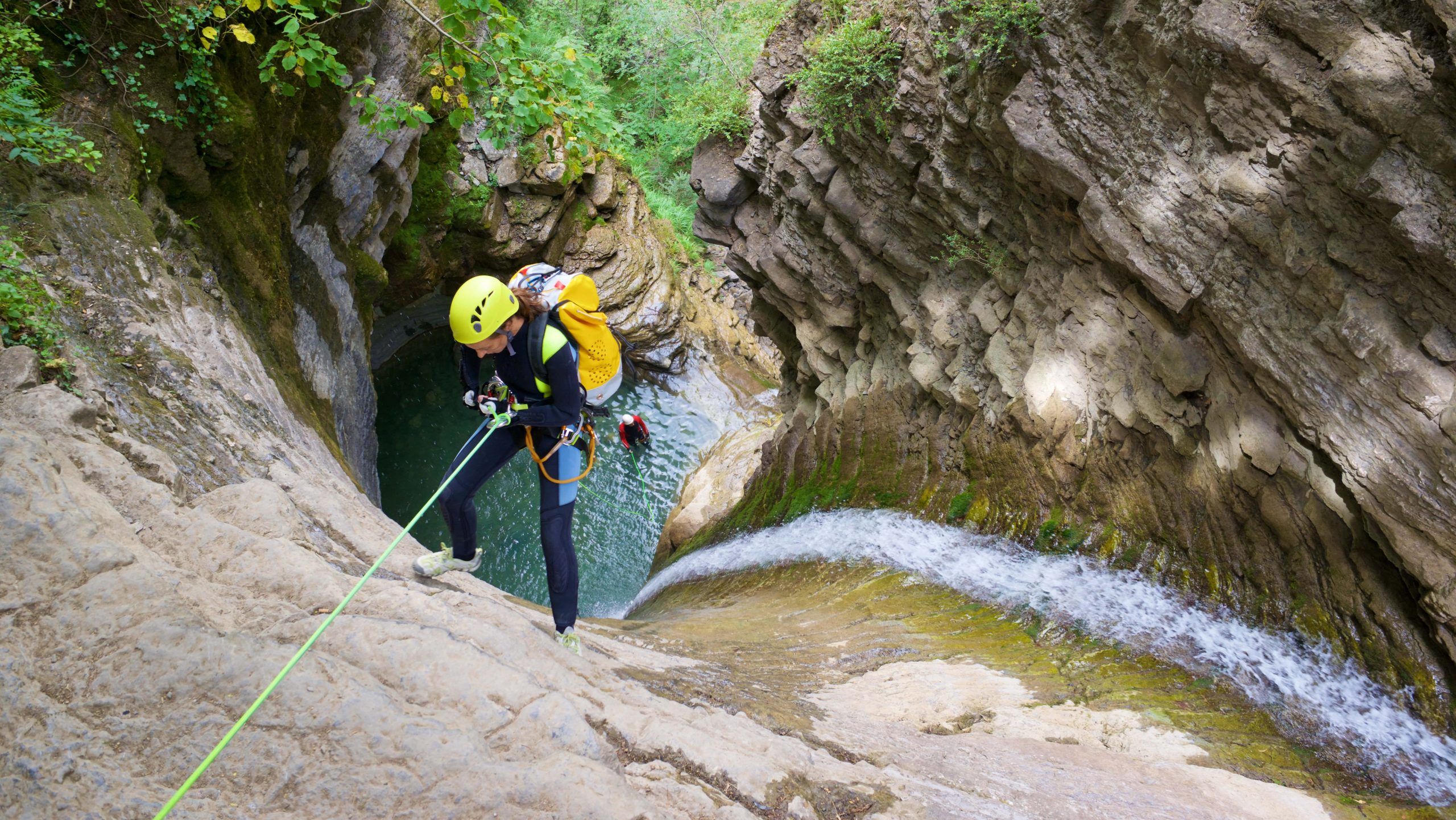
Canyoning Techniques & Terminology
Canyoning is a diverse sport that requires various techniques to navigate through gorges, waterfalls, and rock formations. Here are some key terms and methods used in canyoning:
- Abseiling – A controlled descent down steep rock faces using a rope and belay device. This technique is essential for sections that are too high or difficult to climb down.
- Bridging, Chimneying & Stemming – These are methods used to move through narrow canyon passages:
- Bridging involves pressing hands and feet against opposite rock walls to span a gap.
- Chimneying requires leaning the back against one wall while pushing against another with the feet.
- Stemming involves using hands and feet on opposing walls to maintain balance and move forward.
- Climbing – Many canyoning routes require climbing over boulders, rock formations, and uneven terrain. Good grip strength and balance are essential.
- Jumping & Sliding – Some sections feature natural water pools where canyoners can jump from ledges or slide down smooth rock chutes, often shaped by centuries of water erosion.
- Swimming & Diving – Water-filled canyons require swimming through pools and, in some cases, diving under rock formations to progress along the route.
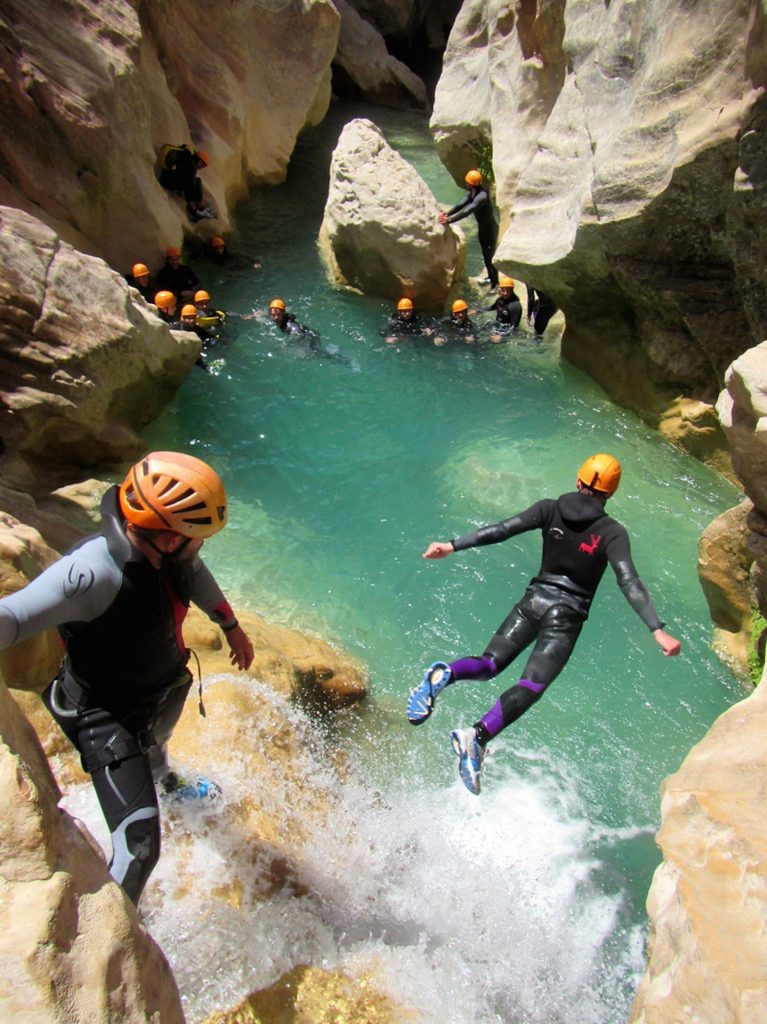
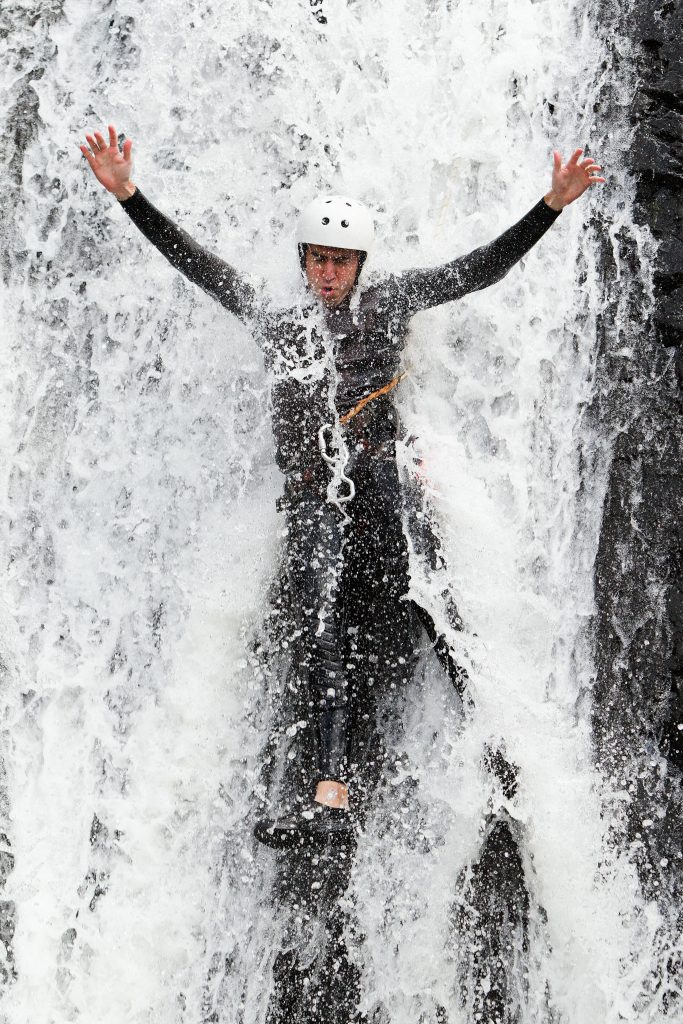
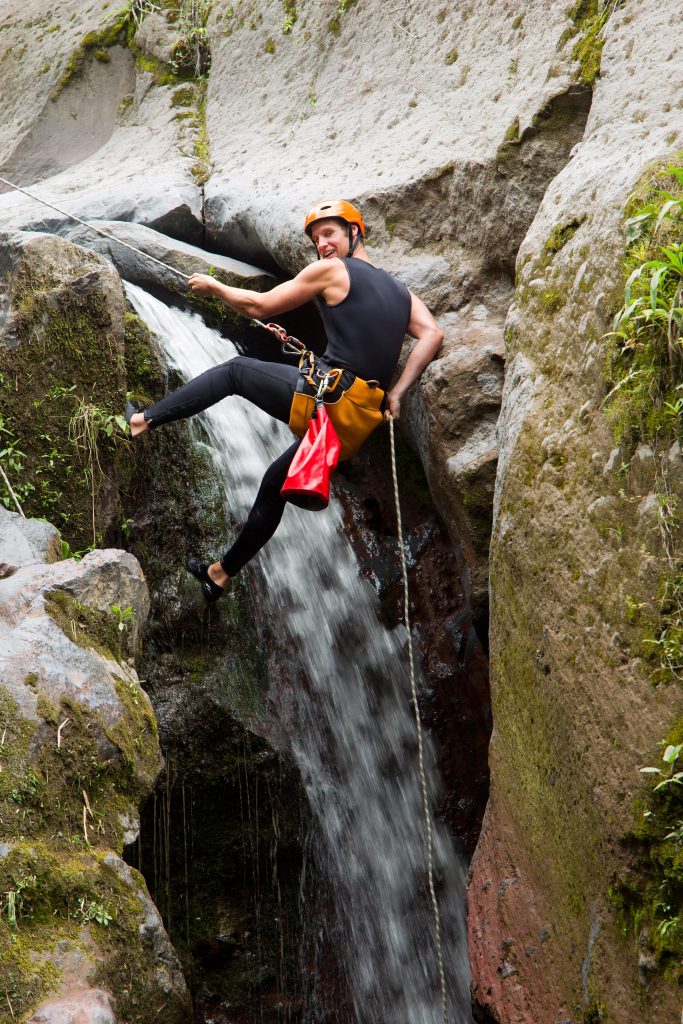
Our Tip: Some of these techniques are a bit more advanced, but if you go with a guide, they will show you what to do and how to properly navigate through the canyon!
Who can do Canyoning?
Canyoning offers adventures for all skill levels, from scenic beginner routes to adrenaline-pumping descents. Routes are usually categorized as easy, medium, or hard, with some allowing alternative paths around high jumps or challenging sections. If you’re a beginner, an easy route is a great start, while those craving more excitement can opt for a medium route. Experienced adventurers can take on the hardest routes for an even bigger challenge.
Beyond the thrill, canyoning is also about teamwork, pushing personal limits, and experiencing untouched nature, making it a popular choice for group activities like bachelor parties, corporate team-building, or school trips.
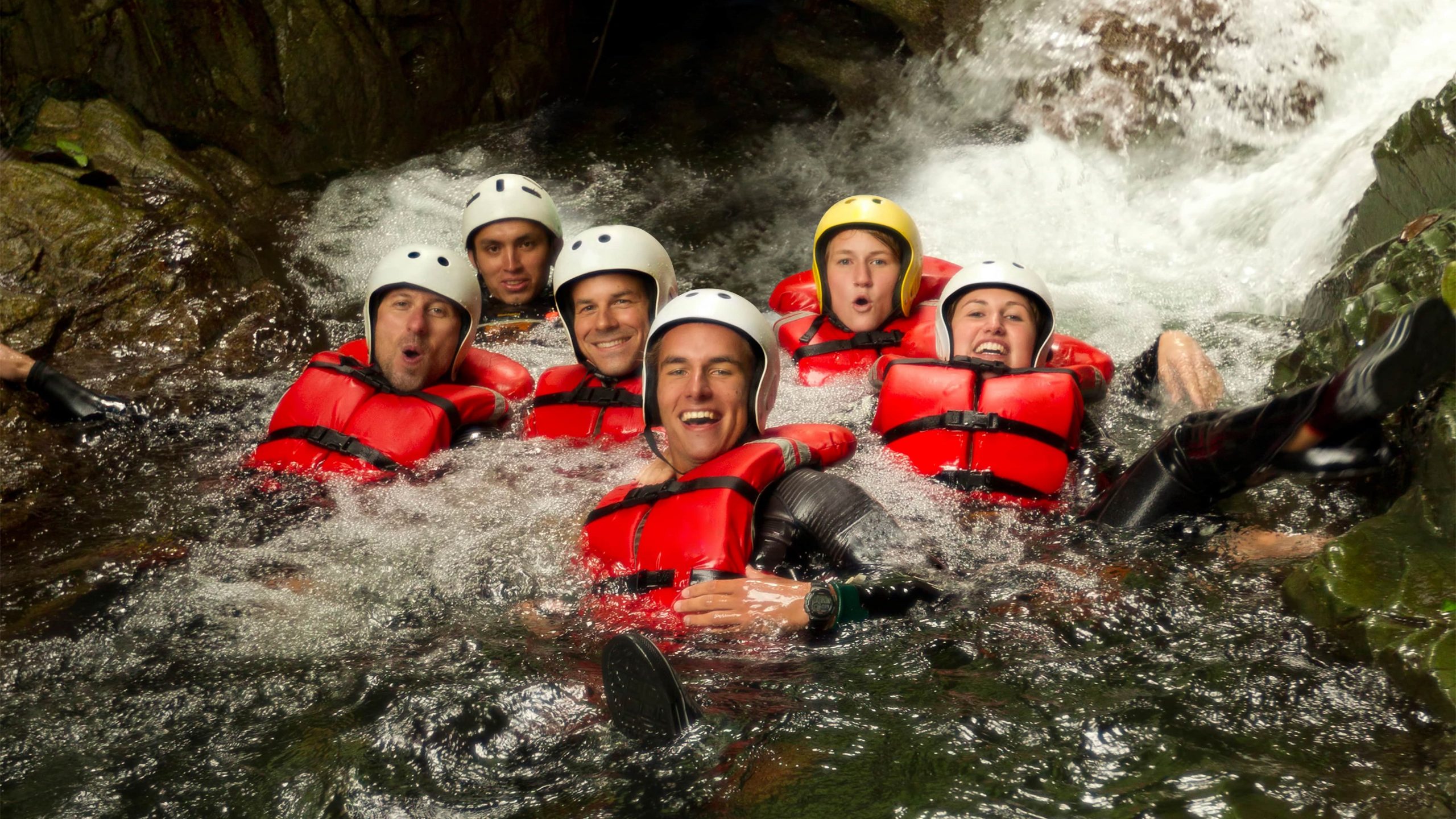
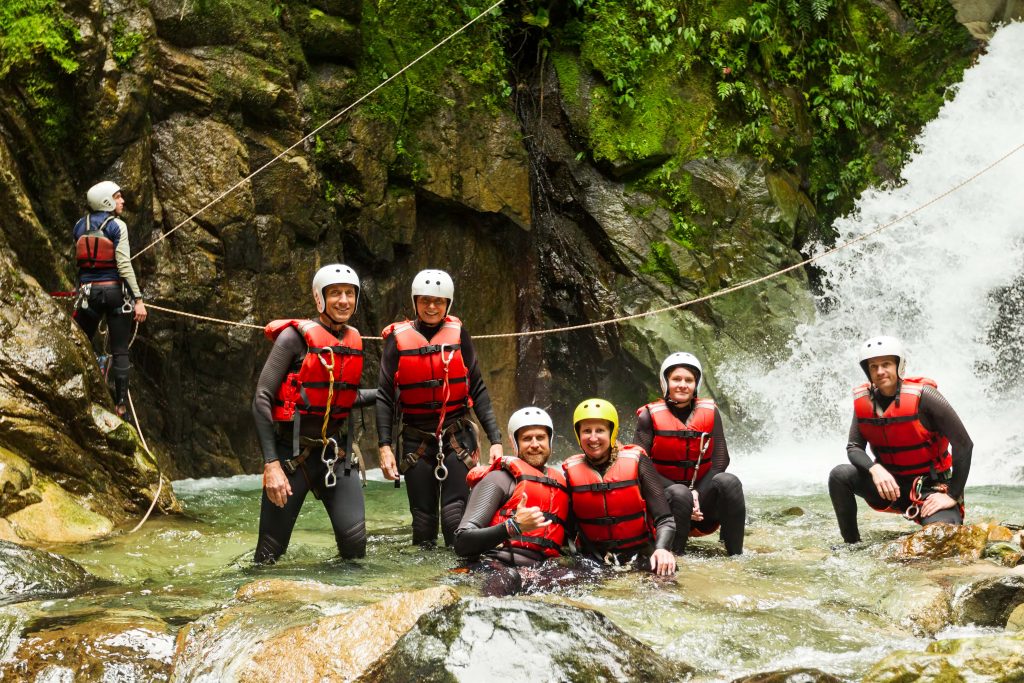
Physical Requirements & Group Canyoning Tours
To go on a guided canyoning tour, participants should be at least ten years old (might vary depending on provider and the difficulty level of the route) and in good physical shape, with some stamina and flexibility. While you don’t need to be a professional athlete, experience in outdoor activities is helpful, especially walking on uneven ground. A basic swimming ability is essential, as you’ll encounter waterfalls and pools. It’s also important to be comfortable with heights, as some sections may involve high jumps or abseils, which often don’t have alternative routes. Once you begin a canyoning course, there’s no turning back—you’ll need to complete it, including any long walks back.
Safety is a priority, so group sizes are typically limited to eight people, ensuring the instructor can monitor each participant closely. Everyone in the group should have a similar fitness level, as the group must stay together throughout the course. Those with vertigo, heart conditions, joint issues, or past injuries should consult the provider beforehand. Canyoning is about enjoying nature, pushing your limits, and embracing the adventure, so make sure you’re ready for an active, thrilling experience in beautiful landscapes.
The best time to do Canyoning
The best time for canyoning depends on the region, canyon conditions, and weather. Ideally, it’s best to go during the rainy season when water levels are high, waterfalls are flowing, and pools are filled, enhancing the experience. Dry seasons can lead to lower water levels, missing key highlights like jumps and slides.
For example, Mallorca’s best time is from October to April, while southern Germany’s prime season is from April to October. Winter is too cold for most regions.
In general, while there’s no one-size-fits-all answer, late spring to early autumn is ideal. Starting in the early morning is also recommended to avoid the heat and enjoy more time in the canyon.
The right Canyoning Equipment
For a canyoning tour, having the right equipment is essential. Many providers supply most of the gear as part of the tour package, including:
- Wetsuit (or jacket and pants)
- Neoprene socks
- Helmet
- Life jacket
- Safety harness
- Carabiners
- Rappelling device
- Canyoning belt
Your guide will carry additional essential items like a first-aid kit, ropes, and a knife. Some providers may offer extra gear, while others may charge a rental fee for certain items. It’s best to check with your provider about what’s included.
You should bring a swimsuit (or synthetic underwear) to wear under the wetsuit for hygiene reasons. If you have trekking shoes, bring them as well—they’ll be more comfortable than rentals. Don’t forget a towel and a change of clothes, as you’ll get wet during the tour. Afterward, you’ll appreciate the comfort of dry clothes!
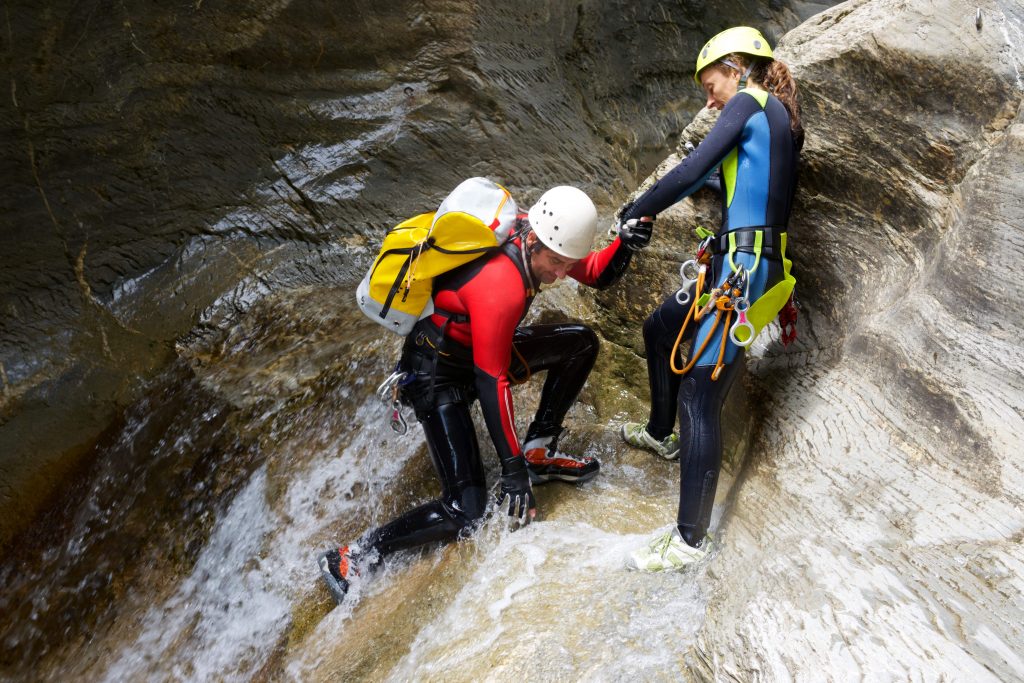
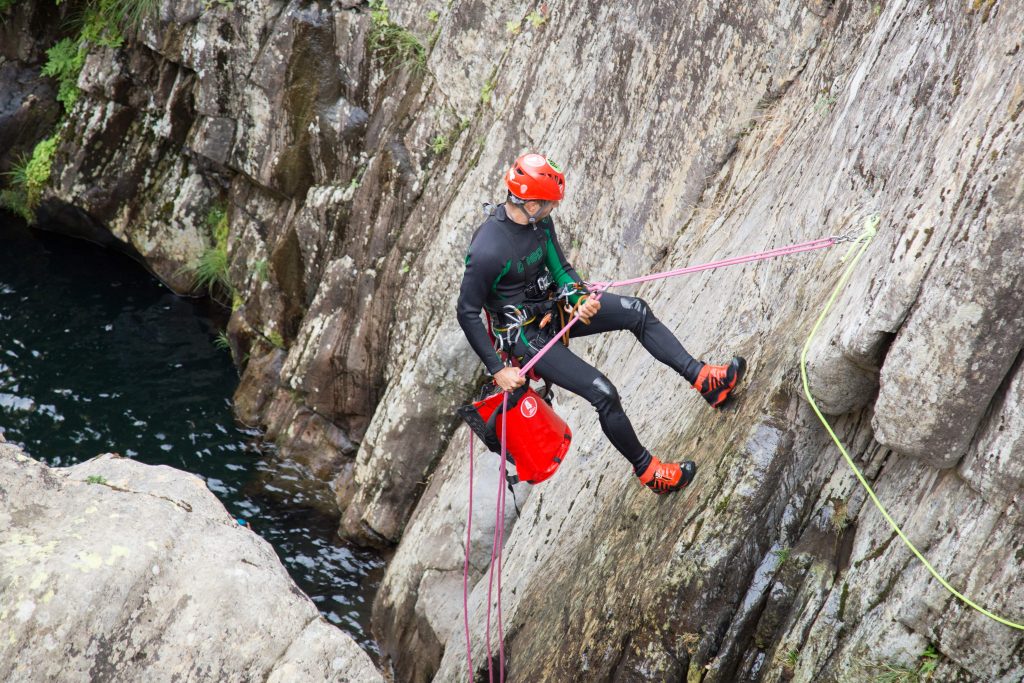
The 8 best spots in Europe for Canyoning
Europe offers many incredible canyoning spots for different fitness and difficulty levels. Which one you choose depends on what kind of adventure you are looking for. Here is our top 8 spots in Europe for canyoning , including some of their highlights:
- Verdon Gorge, Provence, France
A must-see with its iconic turquoise waters, perfect for intermediate and advanced canyoners looking for exciting descents. - Alpes-Maritimes (Nice, Gorges du Loup), France
Ideal for all levels, including beginners, with stunning waterfalls and natural slides that make it a favorite for canyoning. - Tirol, Austria
Explore the stunning gorges of Tirol, including Kobelache and Almbachklamm. A fantastic destination for all difficulty levels, especially in the breathtaking Alps. - Lake Garda, Italy
Beautiful canyons surrounded by lakes and mountains. Perfect for both beginners and experienced adventurers seeking a fun and scenic experience. - Interlaken, Switzerland
A canyoning hotspot in the Swiss Alps, offering a variety of routes for thrill-seekers, with spectacular mountain views and challenging descents. - Triglav National Park, Slovenia
Known for its pristine natural beauty and crystal-clear waters, this park is a great place for canyoning enthusiasts of all levels. - Tramuntana Mountains, Mallorca, Spain
Escape to Mallorca’s rugged landscapes, where steep limestone cliffs, rushing waterfalls, and narrow gorges await—perfect for canyoning adventures. - Epirus, Greece
A hidden gem for canyoning, Epirus offers rugged gorges, lush landscapes, and crystal-clear rivers. With thrilling descents and dramatic rock formations, it’s perfect for adventure seekers looking to explore Greece’s wild side.
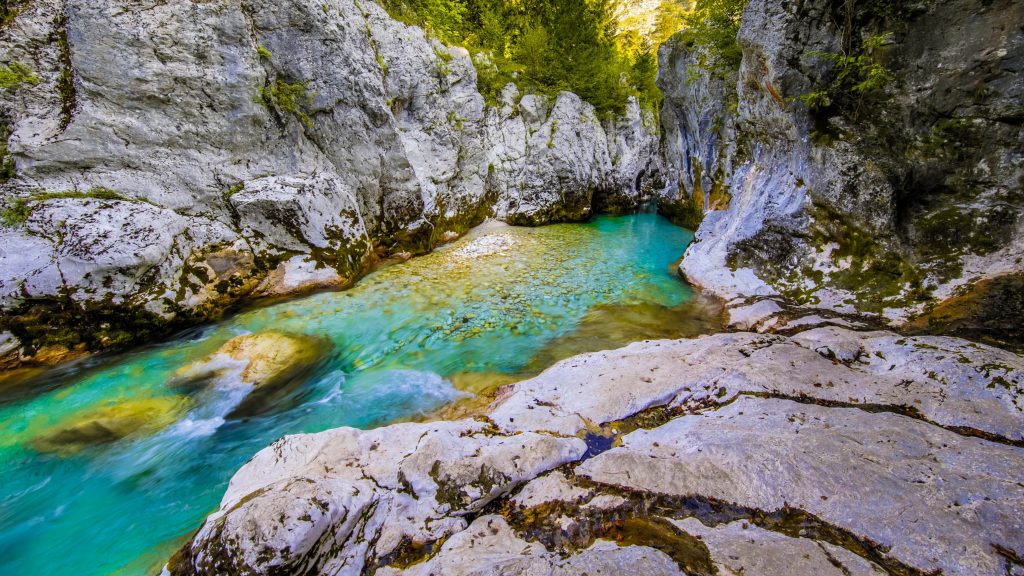
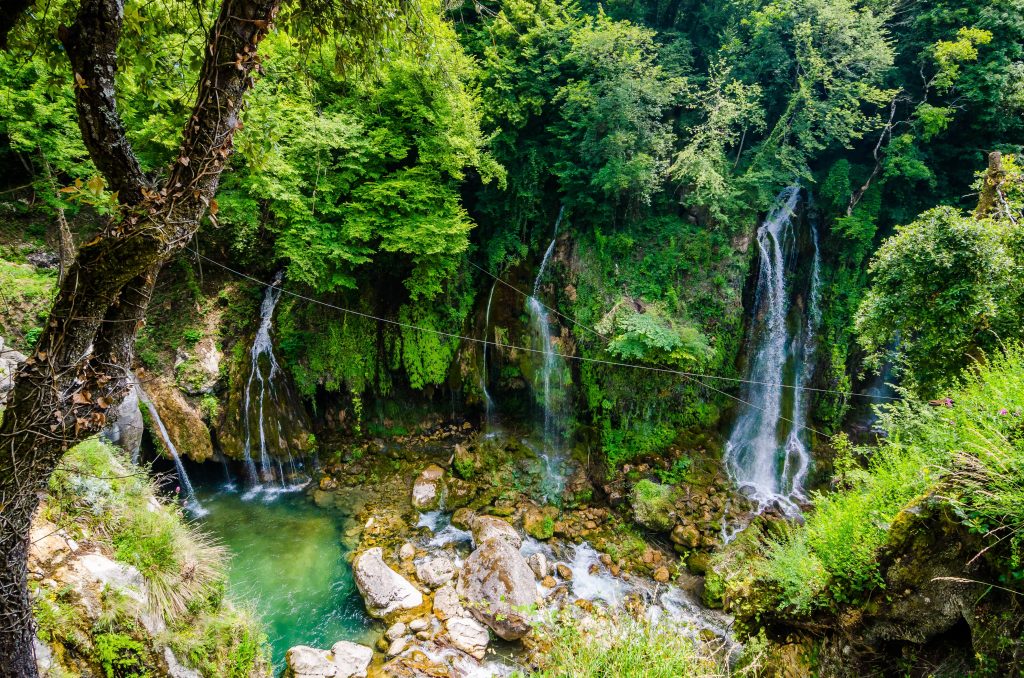
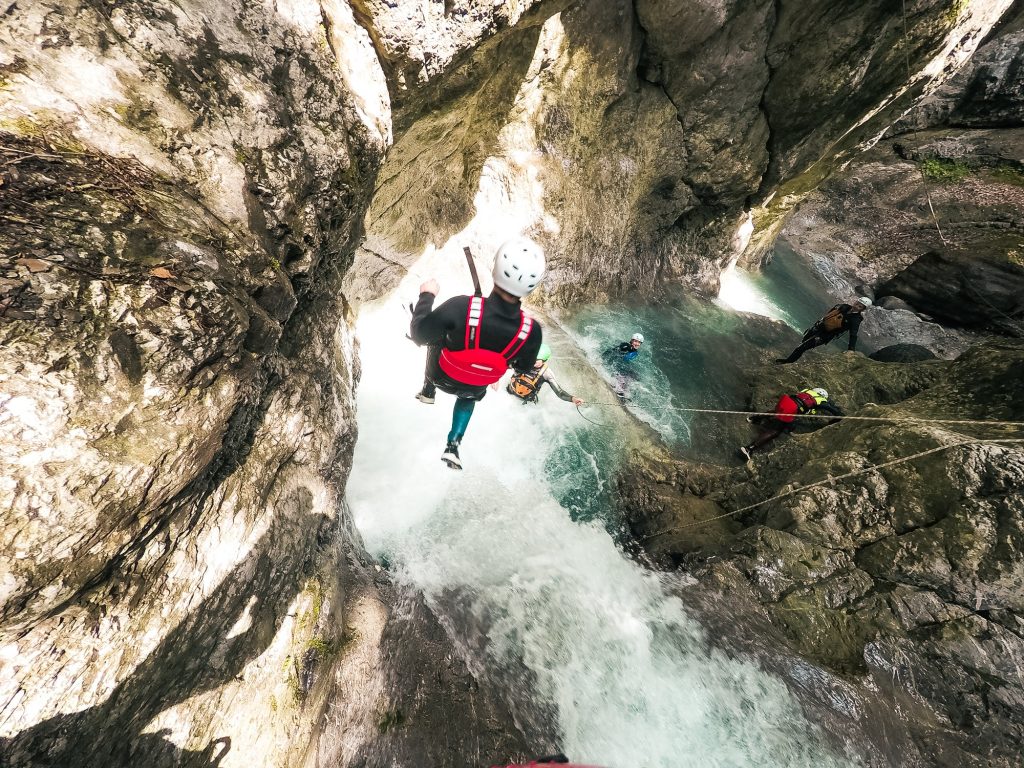
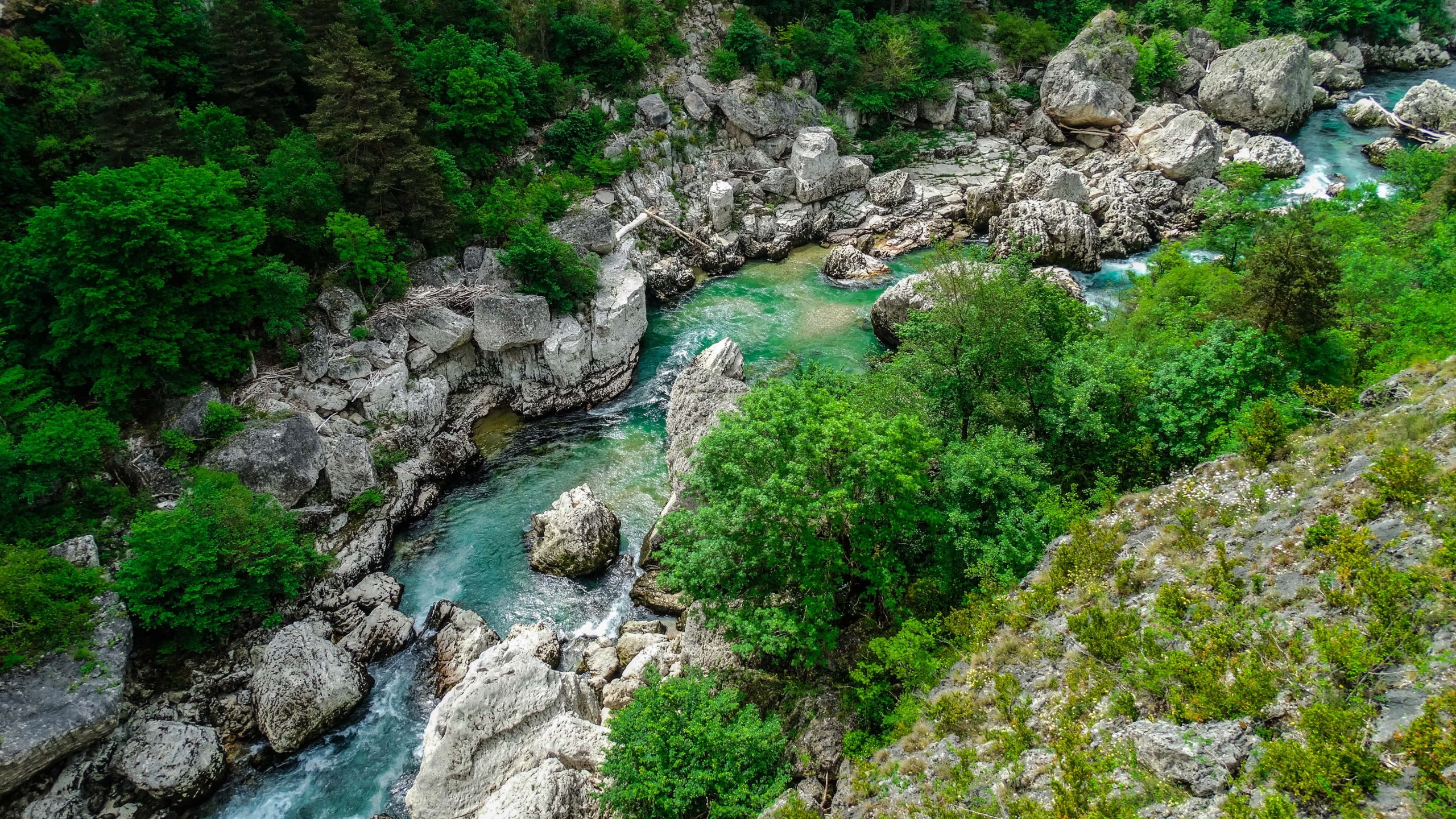
Frequently Asked Questions & Tips for Beginners
Now that you know all the technicalities, here some more tips so you are ready and well prepared for your canyoning adventure:
- Is canyoning dangerous?
- As canyoning is an extreme sport, there are certain risks that come with it, like slippery rocks and strong currents, but with a professional guide, it’s much safer. Guides provide proper equipment, assess conditions, and ensure you use the right techniques. Choosing a suitable route and following their instructions makes canyoning an exciting and controlled adventure.
- Do I need previous experience?
- For easy routes, you do not need any prior experience. A guide will give you proper safety instructions and familiarize you with the equipment. Usually, there are also alternative routes for less experienced participants, so you do not have to worry about your first canyoning experience.
- How much does canyoning cost?
- Canyoning prices depend on factors like tour duration, difficulty, location, and included services. Short beginner tours are generally more affordable, while advanced, full-day excursions cost more. Prices can range widely, so it’s best to compare providers and check what’s included. On average, an activity is between €50-150.
- Can kids participate in canyoning?
- Most canyoning tours require a minimum age of 8 years. Some tours might even have a higher minimum age or height, as there will be sections that would make it hard to get past otherwise. However, some providers offer specially designed canyoning tours for kids and families, or an alternative could be to go river trekking, which is a bit easier than canyoning.
- What do I have to bring?
- Usually, all the equipment you need for canyoning is included in a tour. However, it is always good to bring trekking shoes that can get wet, a second pair of shoes, a change of clothes and towels for after the tour. Bring water and snacks, if you can carry a backpack (or sometimes the guide will carry it for you). If you want to capture your adventure, you can also bring action cameras like a GoPro.
- What are requirements for canyoning?
- Physical fitness, swimming ability, being comfortable with heights, a minimum age of 8 years and no prior injuries are the main requirements for most canyoning tours.
- How do I find the right canyoning route for me?
- Look for tours according to your experience and fitness level. Checking guided canyoning tours with a professional guide online is always a good idea.
Canyoning is an exhilarating way to explore Europe’s most stunning natural landscapes, combining adventure, teamwork, and a true connection with nature. Whether you’re a beginner or an experienced thrill-seeker, there’s a perfect canyoning route waiting for you.
While this sport comes with challenges, going with a professional guide ensures a safe and unforgettable experience. They provide the right equipment, expert instruction, and knowledge of the terrain, significantly reducing risks. So, if you’re ready to push your limits and embrace an outdoor adventure like no other, grab your gear, find a guided tour, and take the plunge into Europe’s breathtaking canyons!
